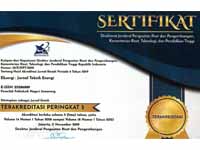PEMBANGKIT PANAS BUMI KAPASITAS 2 KW MEMANFAATKAN SISTEM ENTHALPI RENDAH UNTUK APLIKASI SISTEM OFF-GRID
DOI:
https://doi.org/10.32497/eksergi.v17i1.2285Keywords:
Panas bumi, siklus biner, enthalpi rendah, off gridAbstract
PLTP siklus biner merupakan salah satu solusi alternatif pemanfaatan panas bumi yang memanfaatkan sistem entalpi rendah. Skala percobaan pembangkit listrik siklus biner bertujuan untuk mengembangkan kemungkinan penggunaan tidak langsung dari sistem panas bumi entalpi rendah di situs Diwak. Unit ini adalah sistem siklus biner 2 kW yang terdiri dari empat komponen utama: evaporator, turbin, kondensor, dan sistem pendingin. Refrigeran R134a dipilih sebagai fluida biner karena kinerja yang diinginkan dan kemudahan ketersediaan di area lokal. Panas ditransfer ke fluida biner di sistem evaporator dengan loop ekstraksi termal. Pendinginan disuplai ke pipa ganda kondensor kemudian diedarkan sebagai loop pada sistem menara pendingin. Turbin putar digunakan sebagai ekspander untuk mengekstraksi pekerjaan dari sistem dan diumpankan oleh evaporator bertekanan tinggi. Sistem telah dirancang dan dibangun dan sekarang siap untuk komisioning dan pengujian.
References
Referensi
Cengel Y.A., and Boles M.A., (2005), Thermodynamics: An Engineering Approach, Fifth edition, United States of America, McGraw-Hill.
Bergman T.L., Lavine A.S., Incropera F.P., and Dewitt D.P., (2011), Fundamentals of Heat and Mass Transfer, Seventh edition, United States of America, John Wiley & Sons.
Dipippo R., (2008), Geothermal Power Plant: Principles, Applications, Case Studies, and Environmental Impact, Second edition, United States of America, McGraw-Hill.
Liu X., Wang X., Zhang C., Sensitivity analysis of system parameters on the performance of the Organic Rankine Cycle system for binary-cycle geothermal power plants, Applied Thermal Engineering 71 (2014) 175-183.
Orosz M., Lemort V., and Lebrun J., Experimental study and modelling of an Organic Rankine Cycle using scroll expander, Applied Energy 87, 4 (2009), 1260-1268.
Chen H., Goswami D.Y., and Stefanakos E.K., A review thermodynamic cycles and working fluids for the conversion of low-grade heat, Renewable and Sustainable Energy Reviews 14, 9 (2010), 3059-3067.
Ghasemi H., Paci M., Tizzanini A., and Mitsos A., Modeling and optimization of a binary geothermal power plant, Energy 50 (2013) 412-428.
Imran M., Usman M., Park B.S., Kim H.J., and Lee D.H., Multi-objective optimization of evaporator of organic Rankine cycle (ORC) for low temperature geothermal heat source, Applied Thermal Engineering 80 (2015) 1-9.
Zeyghami M., Performance analysis and binary working fluid selection of combined flash-binary geothermal cycle, Energy 88 (2015) 765-774.
Wang X., Liu X., and Zhang C., Parametric optimization and range analysis of Organic Rankine Cycle for binary-cycle geothermal plant, Energy Conversion and Management 80 (2014) 256-265.
Ayub M., Mitsos A., and Gashemi H., Thermo-economic analysis of a hybrid solar-binary geothermal power plant, Energy 87 (2015) 326-335.
Dipippo R., Second law assessment of binary plants generating power from low-temperature geothermal fluids, Geothermics 33 (2004) 565-586.
Wang J., Wang J., Dai Y., dan Zhao P., Thermodynamic analysis and optimization of a flash-binary geothermal power generation system, Geothermics 55 (2015) 69-77.
Downloads
Additional Files
Published
Issue
Section
License
Authors who publish with this journal agree to the following terms:Authors retain copyright and grant the journal right of first publication with the work simultaneously licensed under a Creative Commons Attribution License that allows others to share the work with an acknowledgement of the work's authorship and initial publication in this journal.
Authors are able to enter into separate, additional contractual arrangements for the non-exclusive distribution of the journal's published version of the work (e.g., post it to an institutional repository or publish it in a book), with an acknowledgement of its initial publication in this journal.
Authors are permitted and encouraged to post their work online (e.g., in institutional repositories or on their website) prior to and during the submission process, as it can lead to productive exchanges, as well as earlier and greater citation of published work (See The Effect of Open Access).






